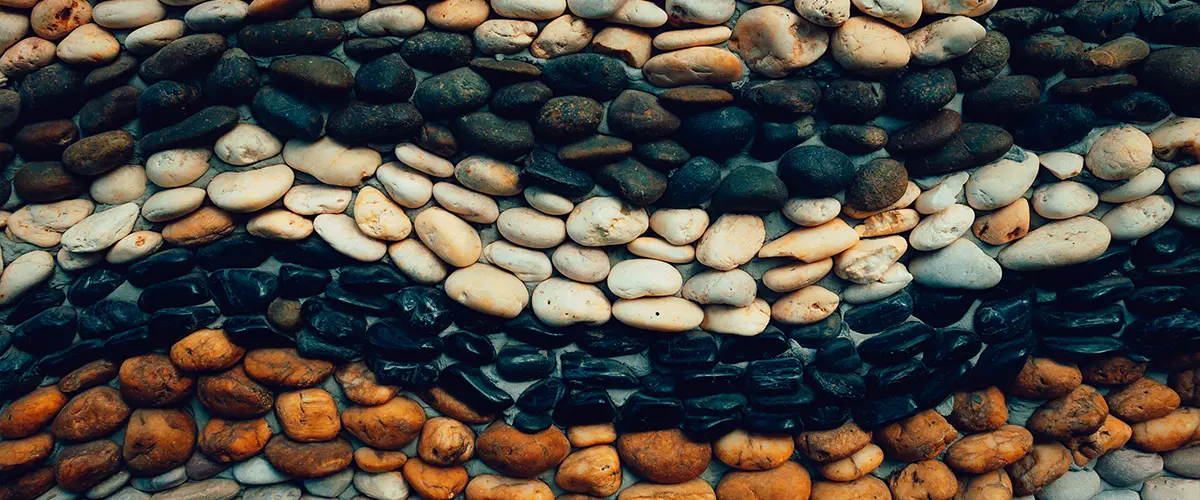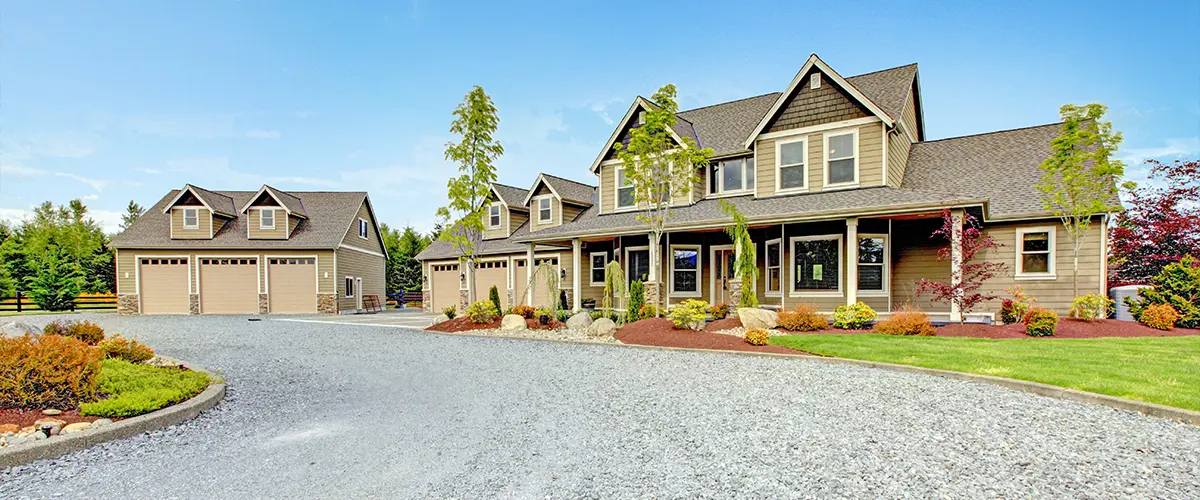Choosing Between Gravel vs Pebble: Which Is Right For You?
Picking between gravel and pebbles for your garden can be tough. Both have their own benefits for a yard or pathway. This article will guide you in choosing the right material based on aesthetics, drainage, and maintenance.
Find out which suits you best!

Understanding the Difference Between Gravel and Pebbles
Composition
Crushed rock forms the basis of gravel, consisting mainly of pieces from larger stones that have been broken down. These pieces are usually angular, creating a stable surface that locks together better than smoother shapes.
This composition enables excellent drainage and makes it an ideal base for paths or driveways.
Pebbles, on the other hand, come from natural stone rounded over time by flowing water. The rounder shape gives pebbles a distinct look and feels underfoot, making them popular for garden pathways and decorative features.
They vary in size but are generally larger than gravel stones, offering unique patterns wherever used.
Whether you opt for the angular rock compositions of gravel or prefer the smooth individuality of larger pebbles, both materials bring their own character to garden designs.
Appearance
Gravel has a rough and rugged look that adds texture to landscapes. Its small, crushed stones vary in color, often found in shades of gray, brown, and white. This mix creates a natural feel perfect for garden paths or driveways.
Pebbles offer a more polished appearance with their smooth, round shapes. These stones come in a broader spectrum of colors, making them ideal for decorative features or to highlight certain areas in your garden.
People often choose gravel or pebbles based on the specific style they want to achieve. Gravel suits those looking for a rustic vibe while pebbles appeal to anyone desiring an elegant touch.
Both materials can reduce weeds when used with a weed mat underneath, ensuring your outdoor space stays neat and tidy without constant maintenance.
Adding either material will instantly elevate the appearance of any landscape project by introducing elements of good drainage and aesthetic appeal according to personal preference.
Functionality
Pebbles and gravel serve different functions in landscaping and construction projects. Pebbles, with their smooth surfaces, are ideal for areas where comfort and aesthetics are priorities, like pathways or garden beds where people might walk barefoot.
They provide a stable surface while adding texture and visual appeal to outdoor spaces.
Gravel, on the other hand, offers excellent drainage properties making it suitable for driveways, foundations, and as a base material under pavers. Its ability to compact tightly helps prevent weed growth and ensures stability in high traffic areas.
Both materials come in various sizes and colors, allowing for creative flexibility in design projects involving two materials such as gravel vs pebble comparisons.

More to read on the topic: Crushed Concrete vs. Gravel
Factors to Consider When Choosing Between Gravel and Pebbles
Personal preference
Aesthetic appeal
When it comes to choosing between gravel and pebbles, the aesthetic appeal is a crucial factor. Quality materials like different stones add texture and visual interest to outdoor spaces.
Gravel provides a rustic look, while pebbles offer a more polished appearance, tailored towards enhancing the overall design of your landscape.
Drainage
Both gravel and pebbles offer effective drainage due to their porous nature, allowing water to seep through and prevent standing water in your outdoor spaces. This crucial feature helps to maintain the health of your plants by preventing root rot and soil erosion.
When choosing between gravel and pebbles, consider the unique drainage needs of your landscaping project for optimal results.
Strategic placement of either material can help manage runoff from heavy rains, ensuring that excess water is diverted away from structures or low-lying areas.
By selecting the right type of gravel or pebble based on their size and composition, you can effectively regulate moisture levels in your garden or yard while enhancing overall aesthetics.
Weed control
Gravel and pebbles can help control weed growth when placed as a barrier in landscaping. The weight and size of these materials make it difficult for weeds to penetrate the surface, reducing maintenance efforts.
Regularly topping up with fresh gravel or pebbles further inhibits weed germination and growth, providing long-term weed control for your outdoor space.

Advantages and Disadvantages of Gravel and Pebbles
- Cost
Gravel and pebbles vary in cost. Gravel is generally more affordable than pebbles due to its wider availability. The cost of gravel can be further reduced by choosing a local variety, whereas pebbles are often imported and may come with a higher price tag.
Consider your budget when deciding between the two options.
- Maintenance
Regular maintenance is essential for keeping both gravel and pebbles looking fresh and tidy. This involves raking the surface to redistribute the stones and prevent uneven patches from forming.
Additionally, removing any debris or leaves promptly will help maintain a clean and neat appearance for your outdoor space.
To minimize weed growth, applying a weed barrier fabric underneath the gravel or pebbles can be highly effective. This prevents weeds from taking root while still allowing water to drain through.
- Versatility
Gravel and pebbles each have their own versatile uses in landscaping. Gravel is often used for functional purposes such as driveways, pathways, and drainage systems due to its compactness and stability underfoot.
On the other hand, pebbles are more commonly utilized for decorative applications like garden accents, water features, and ground cover due to their smooth texture and aesthetic appeal.
Both materials offer versatility in different aspects of outdoor design, providing options for both function and style.
When it comes to gravel, its versatility shines in its ability to serve multiple practical purposes within a landscape.
From supporting heavy vehicle traffic on a driveway to aiding in effective water drainage around the home or garden area – gravel demonstrates remarkable adaptability across various settings.

Closing Thoughts
Choosing between gravel and pebbles ultimately comes down to personal preference and the specific needs of your landscaping project. Consider factors like aesthetic appeal, drainage requirements, maintenance demands, and cost-effectiveness when making your decision.
Both options offer unique advantages and disadvantages, so weigh these carefully against your priorities before making a choice.
FAQ: Choosing Between Gravel vs Pebble for Your Landscaping
Gravel is composed of small, angular pieces of rock, making it ideal for pathways and driveways due to its stability and excellent drainage properties.
Pebbles are smoother and rounder, often used for decorative purposes in gardens and around features due to their aesthetic appeal.
Gravel is typically used for driveways, walkways, and paths, while crushed concrete is often used as a base material. For a more detailed look, check the pros and cons of pea gravel and crushed stone to guide your landscaping projects.
Discover the Best Choice for Your Landscaping Needs with Legacy Outdoor Services
Ready to transform your outdoor space with the perfect choice of gravel or pebbles? Legacy Outdoor Services is here to help! Whether you’re aiming for a rustic feel or a polished look, our experts will guide you through every step, ensuring your landscaping not only meets your aesthetic desires but also enhances functionality.
